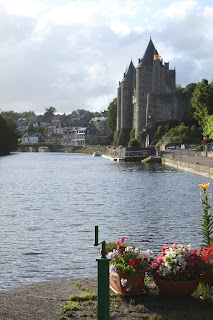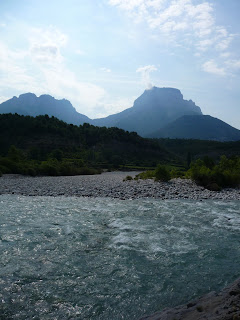Although Brittany is beautiful throughout, it's the coastline that is most spectacular and also varied. It has to be declared outright that the variance includes many megaliths (menhirs, dolmens and so on) that, while mysterious, can start to look like large rocks if you've seen too many. For some the limit is reached sooner than others....

The south coast boasts Carnac, famous for fields of (comparatively small) standing stones arranged in lines that look to be, but aren't quite, straight. Sadly at this time of year you can't simply roam through them at will, but can only be shepherded through in groups with other sheeple. Doesn't do a lot for introspective daydreaming.
Nearby, however, is a much more sparsely populated trail that tracks through and around woods in the area. The trail visits multi-chambered dolmens (which we didn't realise exist), imposingly vast menhirs and flyspeck settlements. Highly recommended for the megalith enthusiast which, as was becoming evident, was more an Andrew than a Tracey thing.

Seafood continued to impress, with a notable highlight being oysters and mussels at a place called "L'Escale" in Locmariaquer. Fabulous quality and a seat next to the seawall, watching as the ebbing tide revealed the beds upon which our oysters had been reared.
Further along to the west is the Crozon Peninsula, in the region called Finisterre ("end of the earth"). Seacliffs look out and down onto the Atlantic, where you can sit and ponder what it would have been like in years past to have sat in the same spot believing that there was no more world beyond you. Fortunately the sun was out in force, so both ocean and cliffs looked amazing. A walk along the cliffs, from Goulien beach to Lost-Marc'h is absolutely worth it.
We stayed in the picturesque canal village of Port Launay. Right nearby is the town of Camaret-sur-mer, on the outskirts of which is a small patch of menhirs. You have to wonder why people went to such lengths to raise the stones, while at the same time guessing that food must have been abundant to be able to devote time to the stones.

Heading to the northern coastline you'll find it far more populated (often by the British) and less rugged but no less beautiful. St Malo is a lovely walled city that sits out on a point surrounded by masted yachts and small (but crowded) beaches with brilliant blue green water dotted by outcrops of small stony islands.

As you drive through the mostly flat northern Brittany coast even from afar you can glimpse the majestic Mont St Michel, a monastery and medieval village that sits on a rocky outcrop. Its only access during high tide is a narrow man-made causeway. During low tide, you can walk hundreds of metres out across the sandy flats. One evening we took a little
pique-nique out to the polders west of the Mont and enjoyed a memorable sunset, with the occasional rabbit and fox.

Along the motorways of France there are many pictured signs that highlight tourist points of interest in the area. One of these signs was for Cancale, its image included oyster...naturally (put intended) we had to visit. We found our way the the port area and with wide eyes, like kids in a candy store, we discovered the "Huites Marche", the oyster markets. This was immensely exciting for us - oysters shucked on the spot, ready to be savoured overlooking a growing midden of shells. What future historians will make of the pile remains to be seen!



 Somehow we'd been led to believe that the Bayeux Tapestry is indeed a tapestry. It's not. It's an enormous, historically significant, piece of embroidery. See it by all means and, unlike Andrew, remember that you can press pause on your audioguide and thereby not be raced around by the flocks of sheeple.
Somehow we'd been led to believe that the Bayeux Tapestry is indeed a tapestry. It's not. It's an enormous, historically significant, piece of embroidery. See it by all means and, unlike Andrew, remember that you can press pause on your audioguide and thereby not be raced around by the flocks of sheeple.












































